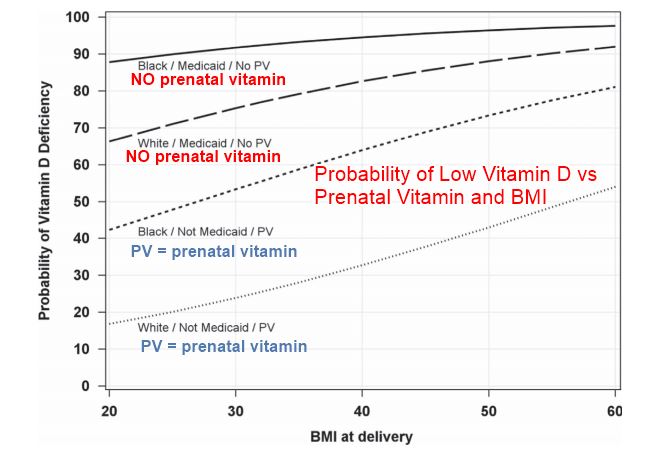Small for gestational age with low vitamin D – 3.6X higher for blacks than whites
Racial disparities in cord blood vitamin D levels and its association with small-for-gestational-age infants
Journal of Perinatology advance online publication 21 April 2016; doi: 10.1038/jp.2016.64
T L Seto1, M E Tabangin2, G Langdon3, C Mangeot2, A Dawodu3, M Steinhoff3 and V Narendran1
1Division of Neonatology and Pulmonary Biology, Cincinnati Children’s Hospital Medical Center, Cincinnati, OH, USA
2Division of Biostatistics and Epidemiology, Cincinnati Children’s Hospital Medical Center, Cincinnati, OH, USA
3Global Health Center, Cincinnati Children’s Hospital Medical Center, Cincinnati, OH, USA
Correspondence: Dr V Narendran, Division of Neonatology and Pulmonary Biology, Cincinnati Children’s Hospital Medical Center, ML 7009, 3333 Burnet Avenue, Cincinnati, OH 45229, USA. E-mail: vivek.narendran@cchmc.org
Vitamin D Levels at birth Blacks and Whites

Table 1

Figure 1 Vitamin D deficiency vs BMI and prenatal vitamins

Note: This study defines vitamin D deficiency as < 20 nanograms
Prenal Vitamins typically have 400 IU of vitamin D
400 IU does help somewhat if you do not have a high BMI
📄 Download the PDF from VitaminDWiki
Objective: To examine the relationship of race and maternal characteristics and their association with cord blood vitamin D levels and small-for-gestational-age (SGA) status.
Study Design: Cord blood vitamin D levels were measured in 438 infants (276 black and 162 white). Multivariable logistic regression models were used to evaluate associations between maternal characteristics, vitamin D status and SGA.
Results: Black race, Medicaid status, mean body mass index at delivery and lack of prenatal vitamin use were associated with vitamin D deficiency. Black infants had 3.6 greater adjusted odds (95% confidence interval (CI): 2.4, 5.6) of vitamin D deficiency when compared with white infants. Black infants with vitamin D deficiency had 2.4 greater adjusted odds (95% CI: 1.0, 5.8) of SGA. Vitamin D deficiency was not significantly associated with SGA in white infants.
Conclusion: Identification of risk factors (black race, Medicaid status, obesity and lack of prenatal vitamin use) can lead to opportunities for targeted prenatal vitamin supplementation to reduce the risk of neonatal vitamin D deficiency and SGA status.
